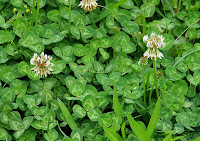WHITE CLOVER, TRIFOLIUM REPENS, SAFED TARFEEL IN URDU
White clover is not used in medicine or cookery as much as red clover is. Both clovers are native to the British Isles, the rest of Europe, and parts of Asia and the Mediterranean. Red clover grows even in the Arctic Circle, and surprisingly perhaps, this is the one we use most although the honey from white clover is recognized as one of the best. Bees will spend more time gathering pollen from the white variety than they will from the red.
White clover is used as a pasture crop when crops are rotated as the microbes in the root system fix nitrogen which means that the plant uses atmospheric nitrogen and converts it into a form that plants can utilize. This helps the soil and crops planted in it the following year will produce a better commercial yield than if the white clover had not been planted in it the previous year.
White clover grows prolifically and when I was a child my father always complained about it as it grew on the lawn along with other weeds such as dandelions, daisies, buttercups and red clover. These days, however, white clover is sold as an alternative lawn covering to grass.
Trifolium means three leaved, and clover can occasionally be four-leaved. This is believed to be lucky and I remember that while at school we once discovered a small patch of four-leaved clovers on the school playing-field. As the annual fete was coming up we decided to display one of our four-leaved clovers and charge people to search for their own. We made quite a bit of money that way and I think one person actually found one that we had missed.
You may remember that in Thomas Hardy’s novel “Far from the Madding Crowd”, the sheep get into the clover field and gorge themselves and have to be ‘punctured’ by Gabriel Oak so that they don’t die. These days, white clover has been developed which doesn’t contain the toxic glycoside which turns into prussic acid in an animal’s body. Deer and other animals and birds can now eat clover with impunity, which is just as well as they seem to relish it.
Masters, writing in 1869 tells us that witches used to gather white clover flowers at night when the moon was full, so that it could be added to their potions along with vervain and other herbs. He also says “…young girls in search of a token of perfect happiness made quest of the plant by day.” By this he must have meant the four-leaved clover, not the ordinary one.
Ella Higginson (1861-1940), an American poet and story writer wrote these lines about the clover: -
“One leaf is for hope and one is for faith
And one is for love, you know,
And God put another in for luck,
If you search, you will find where they grow.”
The white markings on the leaves were believed, in the Middle Ages, to be symbolic of the Holy Trinity by the superstitious peasants. The white clover was first cultivated in the Netherlands and so is sometimes called “Dutch clover”.





No comments:
Post a Comment